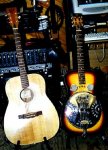Probably just lack of experiance, but all of my final mixes after limiting, eq, reverb, normalizing,etc, sound really low in quality when burned to cd. The volume levels are great, but everything always sounds muddy or low quality and always very bassy. Like it was done on a cheap tape recorder. I have tried everything I can possibly think of, but nothing works. Could I be over processing. Using hard limiting on tracks, normalizing final mixdown etc.? I dont think Im clipping anything. Limit all of the tracks that need it.
I use a MR-8 to record the basic tracks, then do all of my editing and mastering in Cool edit. The stereo wave file out of the MR-8 actuallly sounds better than the finished stereo wave files out of Cool Edit. Any help or suggestions would be greatly appreciated. Thanks.
I use a MR-8 to record the basic tracks, then do all of my editing and mastering in Cool edit. The stereo wave file out of the MR-8 actuallly sounds better than the finished stereo wave files out of Cool Edit. Any help or suggestions would be greatly appreciated. Thanks.


 The blonde's someone who wanted in on the photo opportunity.
The blonde's someone who wanted in on the photo opportunity.